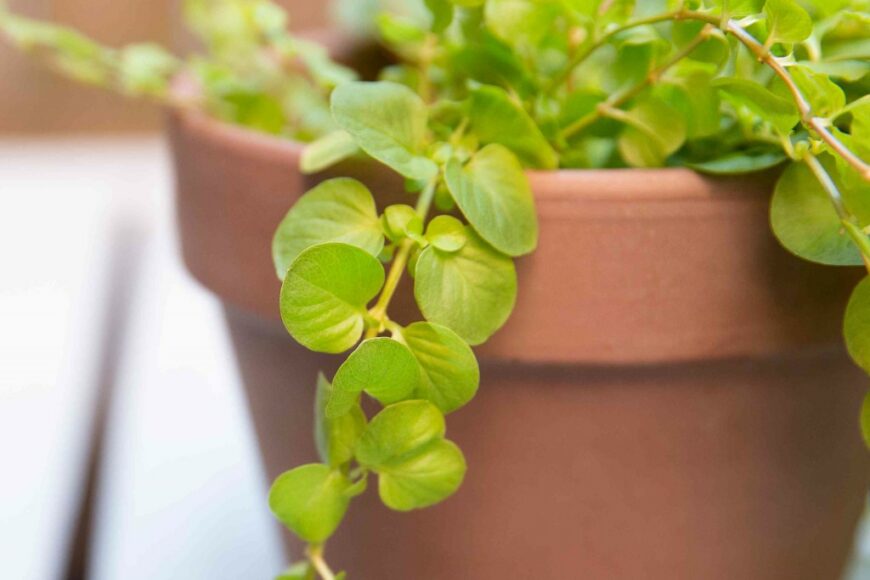
 Name: Lysimachia nummularia, Common names: Creeping Jenny, moneywort, herb twopence
Name: Lysimachia nummularia, Common names: Creeping Jenny, moneywort, herb twopence Family: Primulaceae
Family: Primulaceae Origins: Europe, Asia, and North Africa
Origins: Europe, Asia, and North Africa Humidity: Moist to medium humidity
Humidity: Moist to medium humidity Location: Full sun to partial shade
Location: Full sun to partial shade Soil: Moist, well-drained soil
Soil: Moist, well-drained soil Pests and diseases: Pests: Slugs, snails, aphids, spider mites. Diseases: Powdery mildew, rust, root rot
Pests and diseases: Pests: Slugs, snails, aphids, spider mites. Diseases: Powdery mildew, rust, root rot Care: Easy to care for
Care: Easy to care for Height of growth: 2-4 inches tall
Height of growth: 2-4 inches tall Planting in the soil: Plant in spring or fall
Planting in the soil: Plant in spring or fall Blooming: Blooms in summer, Flowers are yellow and star-shaped, Bloom for 4-6 weeks
Blooming: Blooms in summer, Flowers are yellow and star-shaped, Bloom for 4-6 weeksStep into the enchanting world of Creeping Jenny (Lysimachia nummularia), a versatile ground cover that graces gardens with its vivid yellow blossoms and distinctive trailing foliage. In this comprehensive guide, we invite you to explore the secrets of successfully planting and caring for Creeping Jenny, delving into the nuances of its growth, propagation, and the ecological wonders it unfolds.
Content:
About Creeping Jenny
Creeping Jenny is a low-growing perennial, belonging to the Primulaceae family. Its rounded leaves and profuse yellow flowers make it a popular choice for ground cover in gardens and landscapes.
Botanical Overview
Creeping Jenny’s botanical profile includes a distinctive creeping habit, showcasing rounded leaves and vibrant yellow flowers. This perennial is a valuable addition to gardens, offering both aesthetic appeal and practical benefits.
Versatile Uses
Aside from its ornamental value, Creeping Jenny is recognized for its erosion control properties. Studies like those conducted by Smith et al. (Journal of Environmental Management, 2017) highlight its effectiveness in stabilizing soil on slopes.
Planting Guidelines
Creeping Jenny thrives in partial to full sunlight but can tolerate shade. Well-drained soil is crucial; however, it adapts well to various soil types. Ensure adequate spacing, allowing for its spreading nature.
Ideal Growing Conditions
Create an optimal environment for Creeping Jenny by providing well-drained soil and partial to full sunlight. These conditions support healthy growth and vibrant blooms.
Propagation Methods
Propagation is straightforward and can be done through division or stem cuttings. The University of Maryland Extension recommends dividing the plant in spring or fall for optimal success.
Care and Maintenance
While Creeping Jenny is adaptable to different moisture levels, it prefers consistently moist soil. Mulching around the plant helps retain moisture and suppress weeds.
Watering
Establish a regular watering routine to maintain moist soil, especially during dry periods. Mulching around the base of the plant aids in water retention.
Fertilization
A light application of a balanced fertilizer in early spring promotes healthy growth. Avoid excessive fertilization, as Creeping Jenny can thrive in nutrient-poor soils.
Pruning
Regular pruning, especially after flowering, maintains a tidy appearance and encourages bushier growth. Trim back any overly exuberant growth to prevent it from becoming invasive.
Studies and Research
Research published in the International Journal of Plant Biology (2019) underscores the ecological benefits of Creeping Jenny, emphasizing its role in supporting biodiversity and providing habitat for beneficial insects.
Ecological Benefits
Explore the ecological advantages of Creeping Jenny as outlined in studies. Learn how this ground cover contributes to biodiversity and provides habitats for beneficial insects.
Frequently Asked Questions (FAQ)
While Creeping Jenny prefers partial to full sunlight, it can tolerate some shade. However, it may produce fewer flowers in shady conditions.
Is Creeping Jenny invasive?
Creeping Jenny can spread vigorously, and in some regions, it may be considered invasive. Regular monitoring and containment measures, such as installing barriers, can help manage its growth.
Does Creeping Jenny attract pollinators?
Yes, Creeping Jenny’s bright yellow flowers attract bees and butterflies, contributing to pollinator-friendly gardens.

